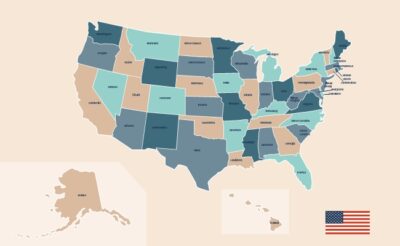
When choosing where to live, safety is often one of the top priorities for individuals and families. From crime rates to emergency preparedness, a wide range of factors determine just how secure life can be in a given state. In this article, we explore the 10 safest states in America, highlight the 5 least safe states, and provide actionable tips for staying safe, no matter where you live.
Source: The data and rankings referenced in this article are based on findings published by Reolink, which evaluated key safety metrics across all U.S. states.
How Are the Safest States in America Ranked?
To assess state-level safety, Reolink used a combination of the following categories:
-
Personal & Residential Safety: Based on FBI data for violent and property crimes per 100,000 residents.
-
Financial Safety: Includes rates of identity theft, financial fraud, foreclosures, and bankruptcies.
-
Road Safety: Encompasses DUI statistics, uninsured drivers, and traffic fatalities.
-
Workplace Safety: Measures injuries, illnesses, and fatal incidents on the job.
-
Emergency Preparedness: Evaluated using FEMA data on state-level disaster readiness and response.
Top 10 Safest States in the U.S.
Here are the ten safest states in America, based on Reolink’s evaluation:
1. New Hampshire
With just 126 violent crimes and 1,011 property crimes per 100,000 people, New Hampshire ranks as the safest state in the nation. The state also boasts low levels of financial fraud and cybercrime.
2. Maine
Maine leads with the lowest violent crime rate (103 per 100,000) in the country and similarly low property crime figures. It’s also among the best-prepared states for natural disasters.
3. Idaho
Idaho records 241 violent crimes and 927 property crimes per 100,000 residents. It also ranks highly for road safety, low DUI rates, and strong workplace protections.
4. Rhode Island
This small state reports 172 violent crimes and 1,285 property crimes per 100,000 residents. Cyber and financial crimes are rare, making it a great place to live safely.
5. Connecticut
Connecticut reports 150 violent crimes and 1,494 property crimes per 100,000 people. The state also shows high levels of disaster preparedness and road safety.
6. New Jersey
With 203 violent crimes and 1,417 property crimes per 100,000, New Jersey benefits from strong consumer protections, DUI enforcement, and cybersecurity efforts.
7. Kentucky
Kentucky sees 214 violent crimes and 1,449 property crimes per 100,000 people. It’s among the safest states thanks to solid consumer protection laws and relatively low rates of workplace injuries.
8. Massachusetts
Massachusetts has a slightly higher violent crime rate (322 per 100,000) but compensates with a low property crime rate of 1,070. It’s also proactive in financial fraud prevention and public safety.
9. West Virginia
West Virginia reports 278 violent and 1,230 property crimes per 100,000. The state maintains active fraud prevention task forces and has low rates of road and workplace incidents.
10. Iowa
Iowa boasts strong emergency preparedness and low rates of both violent crime (287) and property crime (1,331) per 100,000 residents.
Top 5 Least Safe States in the U.S.
While most states perform reasonably well on safety, a few stand out for higher crime and risk factors:
1. New Mexico
With a combined crime rate of 3,764 per 100,000, New Mexico tops the list of least safe states due to high levels of both violent and property crime.
2. Louisiana
Louisiana reports 629 violent crimes and 2,748 property crimes per 100,000 people. It ranks poorly in both financial safety and cybersecurity.
3. Colorado
Despite its scenic reputation, Colorado’s property crime rate of 3,148 and rising cybercrime incidents place it among the bottom five.
4. Arkansas
Arkansas has a total crime rate of 3,097 per 100,000, with frequent traffic accidents and workplace incidents compounding the risks.
5. Washington
Washington sees high property crime (3,356 per 100,000), and lags in emergency preparedness and traffic safety measures.
What Contributes to a Safe State?
States that consistently score high in safety metrics typically share the following characteristics:
-
Effective Law Enforcement: Stringent crime penalties and consistent enforcement.
-
Cyber & Financial Protections: Specialized task forces and consumer support agencies.
-
Robust Road Safety Laws: DUI enforcement, seatbelt laws, and accident prevention programs.
-
Workplace Safety Standards: Routine inspections and compliance programs.
-
Emergency Readiness: Investment in disaster planning, infrastructure, and response teams.
How to Find a Safe State to Live In
When researching safe places to live, consider:
-
FBI and local crime statistics
-
State financial fraud reports
-
Emergency preparedness and FEMA ratings
-
Workplace incident rates
-
Cost of living relative to safety benefits
-
City and neighborhood-level trends
Bonus Tips: How to Stay Safe No Matter Where You Live
-
Install home security systems (like Reolink wireless cameras) for 24/7 monitoring.
-
Use antivirus and identity protection tools to combat online fraud.
-
Enroll in credit monitoring services for real-time alerts on suspicious activity.
-
Drive defensively, obey traffic laws, and avoid distractions.
-
Practice emergency planning with your household.
-
Stay informed about local alerts, advisories, and public safety updates.
Final Thoughts
Whether you’re relocating or just prioritizing peace of mind where you live, choosing a safe state is a critical decision. States like New Hampshire, Maine, and Idaho consistently rank among the best for low crime, strong infrastructure, and high-quality emergency planning. On the other hand, it’s important to research and stay cautious about states with higher crime or weaker safety systems.
Explore your options, protect your family, and make safety a cornerstone of your next move.
Original source: Reolink – Safest States in America
